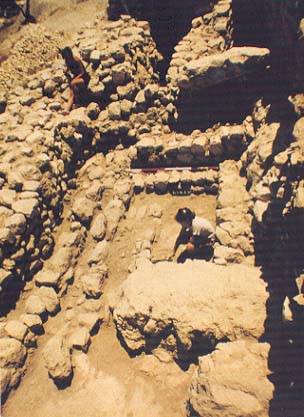Image Details

City of David Archaeological Expedition
Jerusalem’s first houses, dating from the Early Bronze Age (about 3000 B.C.), were built on bedrock on the east slope of the hill, near the Gihon spring. In the house a low bench lines three walls. Outlining the bench on the left and at back are the slightly taller remains of the foundation of the house’s outer wall. The still higher wall, being inspected by a volunteer, top left, dates to the Middle Bronze Age (1800 B.C.) A large mass of bedrock and a smaller one in front of it protrude from the house floor next to another volunteer.
Just ten feet away from the site where this house and another were discovered, the City of David team had dug for five years and had found remains only from the eighth and seventh centuries B.C. (Iron Age). By digging in different areas and using a combination of excavation methods, Shiloh was able to reveal 25 layers of habitation in the City of David; the earliest was a Chalcolithic settlement 5,500 years old—far older than any previously discovered Jerusalem settlement.
